In our suggestions Part 1 HERE we suggested a nice early morning walk to work off your breakfast with a couple of routes we’ve enjoyed. However, whether you walk, catch a bus, bicycle or trishaw, the route for Part 2 starts at the old Northam Road (Jln Sultan Ahmad Shah) Protestant Cemetery. So here are more things to do in Penang.
If you’ve caught a bus 101 that travels along Jln Transfer, get off at the stop just after it turns into Jln Sri Bahari. Walk back to Jln Transfer and turn right. Walk to the end where you see the derelict Shi Chung Branch School, one of the earliest Chinese schools in Penang and hopefully, awaiting restoration. The old cemetery is just beside the school and a plaque at the entrance identifies noteworthy graves, including that of Captain Francis Light, the British founder of the settlement.
From the cemetery, walk a little further along and turn into Jln Penang, walking past the old Ku Din Ku Meh Residence, town house of Tunku Baharudin Tunku, a distinguished Malay administrator and trader at the end of the nineteenth century. Cross the road and admire the wall art before turning left into Jln Muntri and then left again into Jln Leith. Towards the end of the block, you will come to a very noticeable indigo coloured building authentically restored to its original glory after it was privately purchased following the death of the final descendent of the original owner, Chong Fatt Sze.
The Chong Fatt Sze mansion was built in the 1880s as the home and business place of Chong Fatt Sze, a prosperous merchant and he lived here with his favourite and youngest wife. Under the terms of his will the property was not to be sold until the passing of all his children. As was not uncommon in wealthy families of that period, where the patriarch had businesses and families in different locations, there was no cohesion after the elder Chong passed away and his descendants sold property and moved on and this property deteriorated.
When this writer first noticed this building many years ago, it was in a deplorable state, totally unrecognisable from what it had been, but clearly a ‘fallen beauty’. It is testament to the quality of the building materials and fittings as well the dedication of the restorers, that the restored building is now an excellent example of life at the time. Part of the building operates as a boutique hotel, but guided tours are available of the public areas at 11am, 2.00pm and 3.30pm. The tour (in English) costs RM16.95 (prices have risen recently but their website hasn’t been updated yet) and you will be taken round by a well informed guide. The building is not open at other times unless you are a guest.

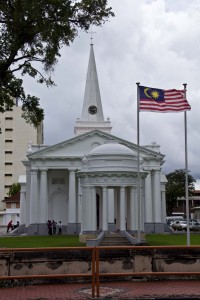
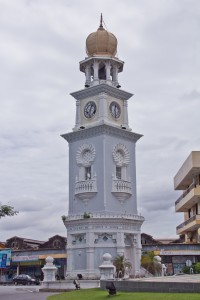
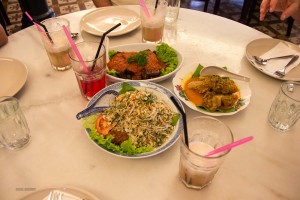


If you decide not to have your lunch in the Chong Fatt Sze Mansion, head off down to Bishop street, via Jln Sultan Ahmad Shah and Lebuh Farquhar. You’ll pass the Catholic Cathedral of the Assumption and a little further on, the recently restored St George’s Anglican Church. Cut across the grounds if the side gate is open and cross to Bishop Street. Towards the other end of the road, you can find Auntie Gaik Lean’s Old School Eatery which serves Nyonya food typical of the local cuisine eaten in the Chong household and of many families in Penang, which are a mix of Chinese and Malay tastes. Try the nutmeg juice, made from local nutmeg and very refreshing. Their melon and sago dessert is also delicious.
After you finish your lunch, continue along Bishop Street and turn left into Beach St (Lebuh Pantai). This is one of the old British trading areas and the banks are located here. At the end of the street, you will see the Queen Victoria Diamond Jubilee Clocktower and to the right, the Swettenham Pier Cruise terminal. Diagonally opposite to the left is Fort Cornwallis, with the Penang State Assembly building hard left.
Fort Cornwallis was built after Captain Francis Light took possession of the island in 1786. The old chapel, built after Captain Light died is said to be where his widow remarried. The entry fee has recently been raised to RM20. However, MyKad holders do get a discount.
From the Fort, wander along the Esplanade – there is some shade at the edge of the Padang, past the Town Hall and Council offices, both of which have been refurbished in recent years. As you continue along past the Court Complex on your left and the Light St Convent on the right, you will be back in front of the Catholic Cathedral of the Assumption. The boys school St. Xavier’s Institution is on the right of the cathedral. Penang has a proud history in education, with many schools tracing their roots back to the early/mid 1800s.
By now you probably need a toilet break and somewhere cool to catch your breath. The Penang State Museum (not to be confused with the Penang Museum in Jln Macalister) was first set up in 1941, but did not survive the Second World War. In 1962, the present museum was set up in the building once occupied by Penang Free School between 1821 and 1927. Entry will cost you the grand sum of RM1 and the toilets are clean and easily accessible on the ground floor. The museum has some interesting displays showing the diverse people of Penang and the first gallery details how many cultures from all over the world have made a home in Penang.
Another building dating from the 1800s is the Eastern & Oriental Hotel, past St Xavier’s Institution and on the seafront. The hotel, like the Raffles (Singapore) and The Strand (Yangon) was established by the four Armenian Sarkies brothers and opened in 1885. Among the famous people who have stayed at the E&O are actors Mary Pickford and Douglas Fairbanks, writers Noel Coward, Rudyard Kipling and Somerset Maugham and the multi talented German-born Swiss poet, novelist, and painter, Hermann Hesse.
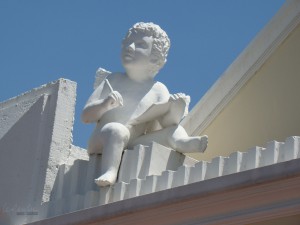
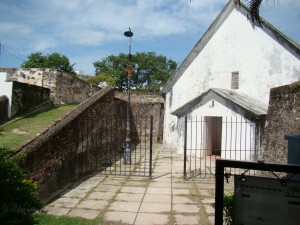
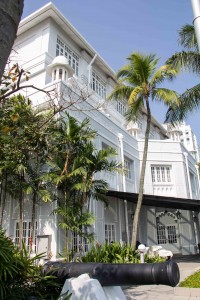
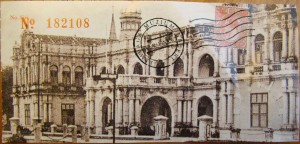
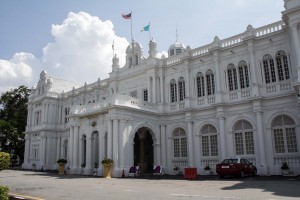
To get from the Museum to the E&O, you can also hop on the outbound Free Bus at the stop (No 6) just in front of the museum. The buses run every day Monday – Saturday between 7am and 7pm at 12 minute intervals. Get off at the next stop just after the bus turns into Jln Penang and backtrack to the end. Cross over and through the pedestrian walk and the E&O Hotel is just in front of you.
Once you are done, retrace your steps to Jln Penang and either board the bus again for a look at some of the old city as you pass by. Stay on board until you reach Jln Kampung Kolam (Stop 15). Get off and continue in the same direction where you will see the Masjid Kapitan Keling on your left, set up in the area by the Indian Muslim residents under the direction of the original Kapitan Keling Cauder Mohuddeen Merican in the early 1800s.
Jln Masjid Kapitan Keling (Pitt Street) is home to houses of worship of the four major religions practiced in Malaysia, testimony to the mixing of communities in the area as it developed. A little further along, on the opposite side of the road is the Sri Mahamariamman temple, built in 1833 and the oldest Hindu temple in Malaysia, which runs between this road and Lebuh Queen. The temple has recently had some renovations done and may or may not be open for a visit.
The Goddess of Mercy temple is further down the road. Built at the beginning of the 19th Century, the temple’s proper name is Kong Hock Keong temple, though nobody actually calls it that. The ornately roofed temple survived the Japanese bombing at the beginning of the occupation in 1941/1942 and is still, even after more than 200 years a centre of activity for devotees, particularly in the third, sixth and ninth months of the Chinese calendar during the Goddess’s birthday celebrations.
You can catch the free bus again at stop no 16, a little further down if you want to travel to the terminus at the Ferry terminal, or elsewhere along the route.
If you prefer to walk from Jln Penang to Jln Masjid Kapitan Keling, you can turn from Bus Stop 7 continuing straight along Jln Muntri to come out just beside the Goddess of Mercy temple. Jln Muntri has a number of restored old shophouses, many of which have been turned into boutique hotels. You can also find the shop where well known shoemaker Jimmy Choo started out and just off the road to the right, in Lorong Stewart, you can find a joss stick maker.
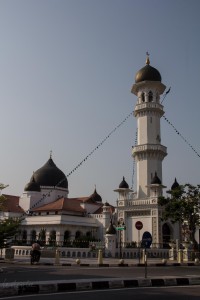
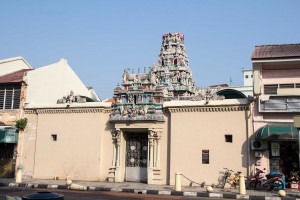
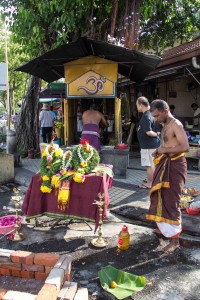

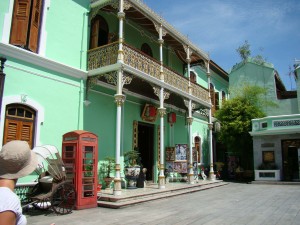
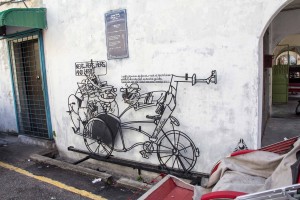
There are many more places in Penang that are definitely worth a visit – allow a couple of hours to appreciate the beautiful collection of Nyonya/Baba jewellery, furniture and other artefacts at the Peranakan Museum in Lebuh Gereja. Entry is RM20 and the museum is open between 9.30am and 5pm every day.
And wherever you go, keep a watch out for the wall art, much of it three dimensional and interactive, with many done by Lithuanian artist, Ernest Zacharevic. The paintings are meant to be done and disappear naturally as they ‘weather’, so don’t be disappointed if the cats you see made out of string, are quietly just fading and moulding away or the paintings are fades or gone. Look out too, for the blue official information plaques on buildings of note and you can’t miss the welded iron art in many locations around the city. These pieces detail early life in George Town and give a little of the history as well. Enjoy.







This Post Has 0 Comments